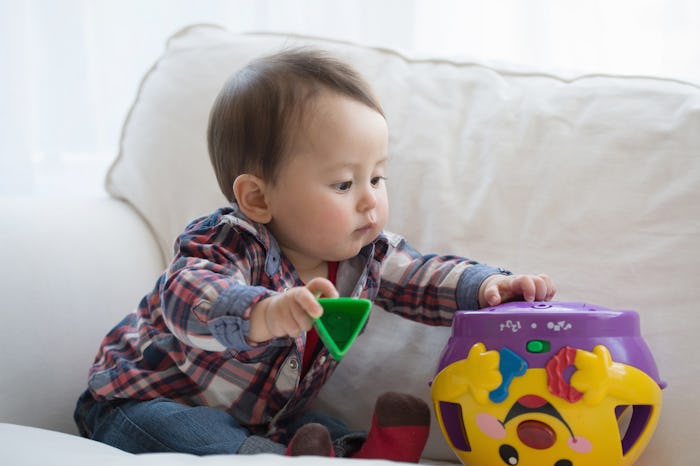Life

Why Do Babies Love Putting Things In Boxes? It’s Actually Good For Them
If you’ve ever given a baby a toy just for them to toss around the box and giggle, you know babies and boxes have a *thing* going on. You may notice they especially love tossing other things into the box, dumping them all out, and starting over again. Why do babies love putting things in boxes so much? While the reason it’s so entertaining is a mystery, child development experts say they’re actually learning with every fill-up and dump-out.
For most babies, the whole filling up a container with smaller items, dumping it out, and starting again routine begins once they can start sitting up. “You typically see it as soon as kiddos have enough core stability to begin using their upper body strength,” says Jana Beriswill, MOTR/L, occupational therapist at Wolfson Children’s Hospital of Jacksonville, in an interview with Romper. “When they become a good sitter around 7 to 8 months old, you’ll start seeing them dumping and exploring their environment in different ways. This is the key developmental thing with the dumping — it’s part of their cognitive development and beginning to understand that they can affect their environment.”
Adria Barnett, OTR/L, occupational therapist at Children’s of Alabama, agrees. She tells Romper that this stage helps babies learn new concepts about the world we live in. “It’s a stage of their cognitive development. They’re beginning to learn how objects relate to each other and cause and effect. What happens when I do this? Repetition is something that helps them learn, and it’s fun for them to see what happens when they do something,” Barnett explains.
Besides teaching them something new, the old fill-it-up-dump-it-out routine helps little ones practice important motor skills. In fact, they’re not just dumping things everywhere and not putting them away to drive you batty. They just haven’t mastered the motor skills to clean up yet.
“Dumping is prominent after we get core stability, but before we get pincer grabbing, like using the thumb and forefinger to grab one Cheerio,” explains Beriswill. “Out is always easier than in, which is why there’s a season where you turn around and your kiddo has dumped everything out. There’s not as much visual feedback when you’re putting things away, and putting things in is harder, so they’ll walk away and leave it because they’ve pushed to the edge of their ability. We’ll often have to teach ‘in.’”
Parents can make sure their baby is developing all of these skills by making sure they have items they can practice with at their disposal. This may also keep them from pulling all their laundry and diapers out of their drawers (and you from putting them all back in again and again).
“I think you can give them some cotton balls or little foam balls and anything safe with a big opening,” says Barnett. “A container that works wonderfully is just an empty Kleenex box. Shape sorting toys are great, and when children are younger you can take the lid off and they can just put the shapes in the big opening. Ring stackers are great too, and the little nesting cups are perfect for this.”
Parents can help baby practice their motor skills and develop cognitively by modeling next steps after dumping. “Dumping is usually one of the first things kids can do by themselves without help from an adult. If Mom is playing, help baby dump, then make a game out of putting things back in. Now we’re dumping the blocks, and now we’re stacking them. Model that next step,” Beriswill says. “I like baskets with washcloths and hand towels. If your drawers are the slow close ones, it’s actually OK for them to open the drawers and explore the house, and that’s a great moment to engage the child in the clean-up and the family rhythms.”
Beriswill adds that parents shouldn’t feel the need to go out and buy toys to facilitate these skills. Using household items is great, and in general, she encourages babies and children to play with toys that aren’t all flashing lights and sound effects.
“It’s always good to give toys that are nice and solid and have less electronic parts, because you want the child’s action to be the most interesting thing about engaging with the toy. You want it to be a thing that requires you to do something to get feedback, so I like when kids play with pots and pans. It helps make connections in their world.”
Experts:
Adria Barnett, OTR/L, occupational therapist at Children’s of Alabama
Jana Beriswill, MOTR/L, occupational therapist at Wolfson Children’s Hospital of Jacksonville